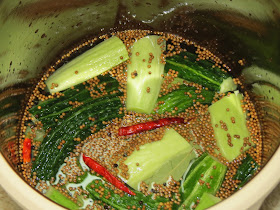We use both cucumbers in fermenting, but the Suyo Long is perfect this time of year for making Tzatziki Sauce to accompany those wonderful zucchini fritters.

A great snack, as a side dish, an hors-d'oeuvre ... cucumbers offer versatility and at only 16 calories in 1 cup, we look forward to a refrigerator well stocked from the garden vines.
Cucumbers in Vinegar and Water
1 1/2 lbs cucumbers, sliced
1 cup white vinegar
2 cups water
1-2 teaspoons Stevia (to taste) or sugar
Mix vinegar, water and stevia in a glass bowl. Add the cucumbers, refrigerate and allow to marinate overnight.
Cook's note: depending upon you preference, vinegar to water ratio can be 1:1, 1:2, 1:3
Other variations include adding a garlic clove and/or sliced onions.
Cucumbers and Cheese
cucumbers, sliced
Parmigiano-Reggiano, sliced
We enjoy an array of cheese and crackers, but why crackers? For a nice twist and a quick hors-d'oeuvre, try a slice of Parmigiano-Reggiano served atop a cucumber slice that has been marinating in the vinegar and water.
Cook's note: we have tried several kinds of cheese, but this is a favorite, as together it offers a nice balance of slightly sweet and sour with a little bit of salty.
Korean Cucumber Salad
3/4 to 1 lb cucumber, sliced
2 TB Rice vinegar
2 tsp soy sauce
1 tsp dark sesame oil
1/2 tsp kosher salt
pinch cayenne (optional)
Whisk together all ingredients and pour over sliced cucumbers. Refrigerate and allow to marinate 1-2 hours, and it's just as good the following day. Makes a great side or snack.
Fermented Cucumbers_ Pickles
And not just any pickle, but the good old fashioned Dill pickle that we seldom see anymore. No vinegar! Fermentation is ancient_ as old as life itself.
We're talking about a simple water-salt-garlic solution (and any other spice you might employ) that is allowed to naturally ferment and create live cultures_ probiotics_ that good bacteria we need in our gut. Studies show probiotic foods as helpful in keeping our digestive system in balance and combating problems with IBS (irritable bowel syndrome), lactose intolerance, vaginal yeast infections, Chron's disease...
In the past our fermentation had been limited to making sauerkraut, but we began fermenting cucumbers several years ago after having acquired Sandor Katz' book The Art of Fermentation, a rather in depth presentation _ the history and science behind all things fermented, should you be so inclined. Another book in our library is The Complete Idiot's Guide to Fermenting Foods.
If you want to get right into making the pickles, here is Sandor's recipe for Dill Pickles from his website, and this from Mark's Daily Apple if you want to make just a quart _ same principle but useful for those with small gardens, no large vessel for fermenting, and a way to see how you like the process. This can be done in a gallon or quart jar, but due to the quantity of cucumbers, an old fashioned crock is our preference.
3 TB sea salt
6 cups water
4 teaspoons coriander seed
2 teaspoons black peppercorns
4 whole garlic cloves, smashed
2 fresh bay leaf (optional)
2 dried chili pepper(optional)
2 fresh dill heads
2 grape leaves
Cucumbers
We prefer cutting the cucumbers in half and then quartering them so they will fit in the jars once fermented. Dissolve the salt in the water. Add spices, grape leaves and cucumbers, and place a clean plate or cabbage leaf... over them. Weight that down with i.e. a clean water-filled jug so that the vegetables stay below the brine while fermenting. Cover the crock with a clean towel.
The process can take up to several weeks; it is important to check them each day and skim any mold that might be accumulating. And too, you should enjoy a taste test to see how they are coming along. You will be amazed at what happens after only 3-4 days.
Once fermented transfer them to gallon or quart jars (along with the brine), refrigerate and enjoy over the next months!
 |
| cloudy brine and sediment is good |
Should you prefer the vinegar and canned Dill pickles, here is a recipe, but I think once you have done this fermenting, there is no going back.





























